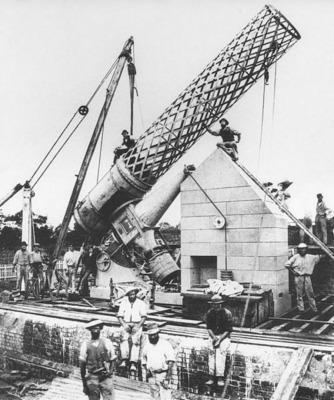 | ||
Location(s) | ||
The Great Melbourne Telescope was built by Thomas Grubb in Dublin, Ireland in 1868, and installed at the Melbourne Observatory in Melbourne, Australia in 1869. In 1945 that Observatory closed and the telescope was sold and moved to the Mount Stromlo Observatory near Canberra. It was rebuilt in the late 1950s. In 2003 the telescope was practically destroyed in a severe bush fire, but a project to restore it to working condition is under way.
Contents
Specifications
The telescope had a 48-inch-diameter (1,200 mm) speculum primary mirror, and was mounted on an equatorial mounting, enabling it to track the stars accurately as they appeared to move across the sky. The design had been approved by a committee of leading British astronomers and scientists. At the time of commissioning it was the second largest telescope operating in the world, after Lord Rosse’s 6 foot reflector at Birr, Ireland, and it was the largest fully steerable telescope in the world.
The telescope was designed to explore the nebulae visible from the southern hemisphere, and in particular to document whether any changes had occurred in the nebulae since they were charted by John Herschel in the 1830s at the Cape of Good Hope.
History
The Great Melbourne Telescope was built by Thomas Grubb in Dublin, Ireland in 1868, and installed at the Melbourne Observatory in Melbourne, Australia in 1869.
After some initial teething problems, the telescope was used for about 20 years at Melbourne Observatory, and one volume of observations produced, along with spectroscopic observations and some pioneering attempts at photographing nebulae. The telescope was upgraded with the addition of photographic equipment in 1872, but the difficulties of repolishing the mirror and the telescope’s relative unsuitability for astrophotography deterred further use.
When Melbourne Observatory closed in 1945, the Great Melbourne Telescope was sold to the Australian Government’s Mount Stromlo Observatory near Canberra. It was rebuilt in the late 1950s with modern drive and a new 50-inch (1,300 mm) pyrex mirror. In the early 1990s the telescope, still utilising Grubb’s original equatorial mounting, was rebuilt with two charge-coupled device (CCD) arrays to detect MACHOs (massive astrophysical compact halo objects).
Destruction
In January 2003 an extreme bushfire destroyed the telescopes and buildings at Mount Stromlo - the temperatures were so high that the aluminium dome itself caught fire and melted onto the telescope, shattering the mirror. The fire-ravaged remnants of the telescope were transferred to Museum Victoria, which had previously acquired discarded parts of the original telescope in 1984.
Restoration project
A project is underway to restore the Great Melbourne Telescope to working order so that it may be used for educational and public viewing in its original home at the Melbourne Observatory. This is a joint undertaking of Museum Victoria, the Astronomical Society of Victoria and the Melbourne Royal Botanic Gardens. The restoration project will incorporate bringing the telescope's optical, mechanical and electrical systems into line with current best practice. After more than five years weighing up different proposals, engineering work commenced in late 2013 thanks to a grant of A$70,000 from the Copland Foundation.
